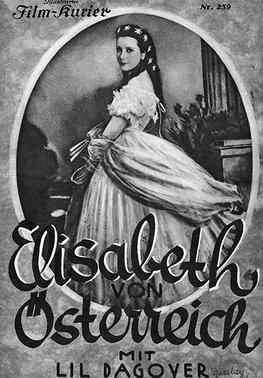
Oskar Homolka was an Austrian film and theatre actor, who went on to work in Germany, Britain, and America. Both his voice and his appearance fitted him for roles as communist spies or Soviet officials, for which he was in regular demand. By the age of 30, he had appeared in more than 400 plays; his film career covered at least 100 films and TV shows.

The Ringer is a 1932 Austrian-German mystery film directed by Martin Frič and Karel Lamač and starring Paul Richter, Maria Matray and Wera Engels. It is a screen adaptation of Edgar Wallace's 1925 novel The Ringer. Another German version, Der Hexer, was made in 1964. It was shot at the Sievering Studios in Vienna. The film's sets were designed by the art director Heinz Fenchel.

Elisabeth of Austria is a 1931 German historical drama film directed by Adolf Trotz and starring Lil Dagover, Paul Otto, and Maria Matray. It is a biopic of Empress Elisabeth of Austria. It was shot at the EFA Studios in Berlin with sets designed by the art director Franz Schroedter.

Oskar Marion was an Austrian film actor.

Night Convoy is a 1932 German drama film directed by James Bauer and starring Vladimir Gajdarov, Olga Chekhova and Oskar Homolka. It was shot at the Babelsberg Studios in Berlin and on location in Hamburg. The film's sets were designed by the art directors Willi Herrmann and Herbert O. Phillips. It premiered on 21 January 1932.

The Serfs is a 1928 German silent drama film directed by Richard Eichberg and starring Heinrich George, Mona Maris and Maria Reisenhofer. It was shot at the Babelsberg Studios in Berlin. The film's art direction was by Jacek Rotmil. It premiered on 11 January 1928 at the Gloria-Palast.
The Prince of Rogues is a 1928 German silent drama film directed by Curtis Bernhardt and starring Hans Stüwe, Lissy Arna and Albert Steinrück. It was shot at the Johannisthal Studios in Berlin. The film's art direction was by Heinrich Richter. The story depicts the life of the 18th century outlaw Schinderhannes. It is based on a 1927 play Schinderhannes by Carl Zuckmayer.

1914 is a 1931 German drama film directed by Richard Oswald and starring Albert Bassermann, Hermann Wlach and Wolfgang von Schwindt. The film focuses on the leadership of the Great Powers of Europe in the days leading up to the outbreak of the First World War, culminating in the assassination of Archduke Franz Ferdinand of Austria by Gavrilo Princip. It was produced at the Babelsberg Studios in Berlin and premiered in the city at the Tauentzien-Palast on 20 January 1931. At the request of the German Foreign Office an introduction by Eugen Fischer-Baling was filmed and presented at the start of the film. A special screening was held at the Reichstag on 3 March 1931.

Maria Matray was a German screenwriter and film actress. Matray became a star of late Weimar cinema.

A Man with Heart is a 1932 German comedy film directed by Géza von Bolváry and starring Gustav Fröhlich, Maria Matray, and Gustav Waldau. It was shot at the Emelka Studios in Munich. The film's sets were designed by the art directors Ludwig Reiber and Willy Reiber. It was remade as the 1935 Swedish film Under False Flag. The film is based on the play A milliomos by Adorján Bónyi.
The Holy Lie is a 1927 German silent film directed by Holger-Madsen and starring Otto Gebühr, Margarete Schlegel, and Paul Bildt.
Did You Fall in Love Along the Beautiful Rhine? is a 1927 German silent romance film directed by James Bauer and starring Philipp Manning, Oskar Marion, and Dorothea Wieck.

Linden Lady on the Rhine is a 1927 German silent film directed by Rolf Randolf and starring Maly Delschaft, Carl de Vogt and Alfred Solm.

Retreat on the Rhine is a 1930 German musical comedy film directed by Jaap Speyer and starring Charlotte Susa, Hans Stüwe, and Hermann Böttcher. It was made as an operetta film which emerged as a popular genre following the arrival of sound film.
The Girl Without a Homeland is a 1927 Austrian-German silent drama film directed by Constantin J. David and starring Jenny Hasselqvist, Henry Stuart, and Oskar Homolka.
Road to Rio is a 1947 American comedy film directed by Norman Z. McLeod and starring Bing Crosby, Bob Hope, and Dorothy Lamour.

In the Employ of the Secret Service is a 1931 German drama film directed by Gustav Ucicky and starring Brigitte Helm, Willy Fritsch, and Oskar Homolka. It concerns espionage between Germany and Russia during the First World War. It was made at the Babelsberg Studios in Berlin with sets designed by the art directors Robert Herlth and Walter Röhrig. Location shooting took place in Denmark.

Between Night and Dawn is a 1931 German drama film directed by Gerhard Lamprecht and starring Aud Egede-Nissen, Oskar Homolka, and Eduard von Winterstein. The film's sets were designed by the art director Otto Moldenhauer. It is a remake of the 1927 silent film Tragedy of the Street starring Asta Nielsen. It was originally intended that she should reprise her role for the sound remake, but ultimately Norwegian actress Aud Egede-Nissen was cast in the role. The film premiered at the Gloria-Palast in Berlin.

Spies at Work is a 1933 German thriller film directed by Gerhard Lamprecht and starring Karl Ludwig Diehl, Brigitte Helm, and Eduard von Winterstein. A spy film, it is set during the First World War conflict between Austria and Italy.

Miss Liselott is a 1934 German comedy film directed by Johannes Guter and starring Magda Schneider, Albert Lieven, and Maria Sazarina. The former silent director Franz Hofer worked as assistant director on the film.















